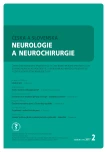“Awake” Resection of Glioma in Semisitting – a Case Report
Authors:
R. Bartoš 1; D. Bejšovec 2; A. Malucelli 1; J. Prokšová 3; J. Lodin 1; Š. Čapek 4; M. Sameš 1
Authors‘ workplace:
Neurochirurgická klinika UJEP a Krajská zdravotní a. s., Masarykova nemocnice v Ústí nad Labem, o. z.
1; KAPIM – Anesteziologická klinika UJEP a Krajská zdravotní a. s., Masarykova nemocnice v Ústí nad Labem, o. z.
2; Rehabilitační oddělení, Logopedie, Krajská zdravotní a. s., Masarykova nemocnice v Ústí nad Labem, o. z.
3; Department of Neurosurgery, University of Virginia, Charlottesville, Virginia, USA
4
Published in:
Cesk Slov Neurol N 2017; 80/113(2): 220-223
Category:
Case Report
doi:
https://doi.org/10.14735/amcsnn2017220
Overview
Background:
Lateral or supine positions are the traditional positions for cranial tumor resections performed with an “awake” component. These positions are used effectively for patients with tumors adjacent to speech centers or located in the superior frontal or precentral gyrus respectively. However, these may be unsatisfactory for tumors in a close proximity to the parieto-occipital region. In this case report, we describe “awake” surgery performed on a patient in semisitting position.
Case description:
A 57-year-old patient suffered second recurrence of a glioblastoma multiforme tumor with subcortical invasion of the postcentral gyrus. Due to a high risk of severe neurological deficit, it was decided to perform an awake surgery with the semisitting position providing the best exposure to the lesion and the pyramidal tract. The pyramidal tract of the patient was mapped using motor responses to regular stimuli during which the surgeon recected the tumor. The patient was fully cooperative throughout the procedure and subjectively described the semisitting position as comfortable. Postoperatively, the patient showed no signs of new neurological deficits. Planned re-radiation therapy was not performed.
Conclusion:
This clinical case demonstrates successful use of the semisitting position in “awake” surgery and we recommend considering its use for tumors in previously challenging locations, such as the lower parietal lobules or postcentral gyrus. This position could also be used during surgeries involving visual pathways mapping.
Key words:
semisitting position – „awake“ surgery – glioma – parietal lobe – pyramidal tract – cortical stimulation mapping
The authors declare they have no potential conflicts of interest concerning drugs, products, or services used in the study.
The Editorial Board declares that the manuscript met the ICMJE “uniform requirements” for biomedical papers.
Chinese summary - 摘要
“醒”半神经胶质瘤切除术 - 病例报告背景:
侧卧位或仰卧位是用“清醒”部件进行颅骨切除术的传统位置。这些位置有效地用于与言语中心相邻的肿瘤患者,或分别位于上额叶或前中回。然而,对于靠近枕骨 - 枕骨区域的肿瘤,这些可能是不令人满意的。在这个案例报告中,我们描述了在半坐姿中对患者进行的“清醒”手术。
案例说明:
一名57岁的患者第二次复发多形性成胶质细胞瘤,伴有中央后回的皮质下侵袭。由于严重神经系统缺陷的风险很高,决定进行清醒手术,半坐姿提供最佳的暴露于病变和金字塔形的道路。使用运动反应来映射患者的金字塔形管道,其中常规的刺激在其中外科医生被切除肿瘤。患者在整个手术过程中完全合作,主观地描述半坐姿舒适。术后,患者没有出现新的神经功能缺损的迹象。未计划再放射治疗。
结论:
这种临床病例证明在“清醒”手术中成功使用半坐姿,并且我们建议考虑将其用于以前具有挑战性的位置的肿瘤,例如较低的顶叶小叶或中央后回。这个位置也可以在涉及视觉途径测绘的手术中使用。
关键词:
半坐位 - “清醒”手术 - 胶质瘤 - 顶叶 - 锥体束 - 皮质刺激图
Sources
1. Hervey-Jumper SL, Li J, Lau D, et al. Awake craniotomy to maximize glioma resection: methods and technical nuances over a 27-year period. J Neurosurg 2015;123(2):325– 39. doi: 10.3171/ 2014.10.JNS141520.
2. Kim S, McCutcheon IE, Suki D, et al. Awake craniotomy for brain tumors near eloquent cortex: correlation of intraoperative cortical mapping with neuroogical outcomes in 309 consecutive patients. Neurosurgery 2009;64(5):836– 46. doi: 10.1227/ 01.NEU.0000342405. 80881.81.
3. Gras-Combe G, Moriz-Gasser S, Herbet G, et al. Intraoperative subcortical electrical mapping of optic radiations in awake surgery for glioma involving visual pathways. J Neurosurg 2012;117(3):466– 73. doi: 10.3171/ 2012.6.JNS111981.
4. Šteňo A, Karlík M, Mendel P, et al. Navigated threedimensional intraoperative ultrasound-guided awake resection of low-grade glioma partially infiltrating optic radiation. Acta Neurochir 2012;154(7):1255– 62. doi: 10.1007/ s00701-012-1357-6.
5. Maldonado IL, Moritz-Gasser S, Menjot de Champfleur N, et al. Surgery for gliomas involving the left inferior parietal lobule: new insights into the functional anatomy provided by stimulation mapping in awake patients. J Neurosurg 2011;115(4):770– 9. doi: 10.3171/ 2011.5.JNS112.
Labels
Paediatric neurology Neurosurgery NeurologyArticle was published in
Czech and Slovak Neurology and Neurosurgery

2017 Issue 2
Most read in this issue
- Ulnar Nerve
- Stroke Incidence in Europe – a Systematic Review
- Anti-NMDAR Encephalitis in Children – a Case Report
- Febrile Seizures – Guidelines for Examination of a Child with Simple Febrile Seizures, Adapted from the Guidelines of the American Academy of Pediatrics
